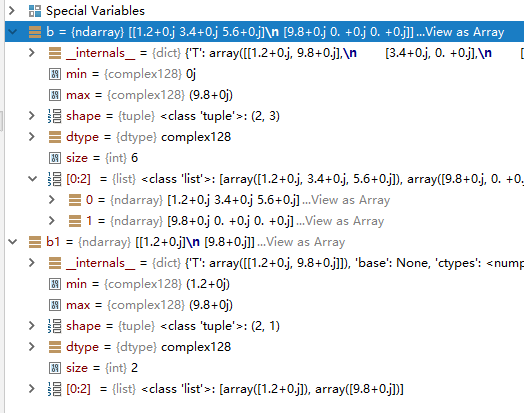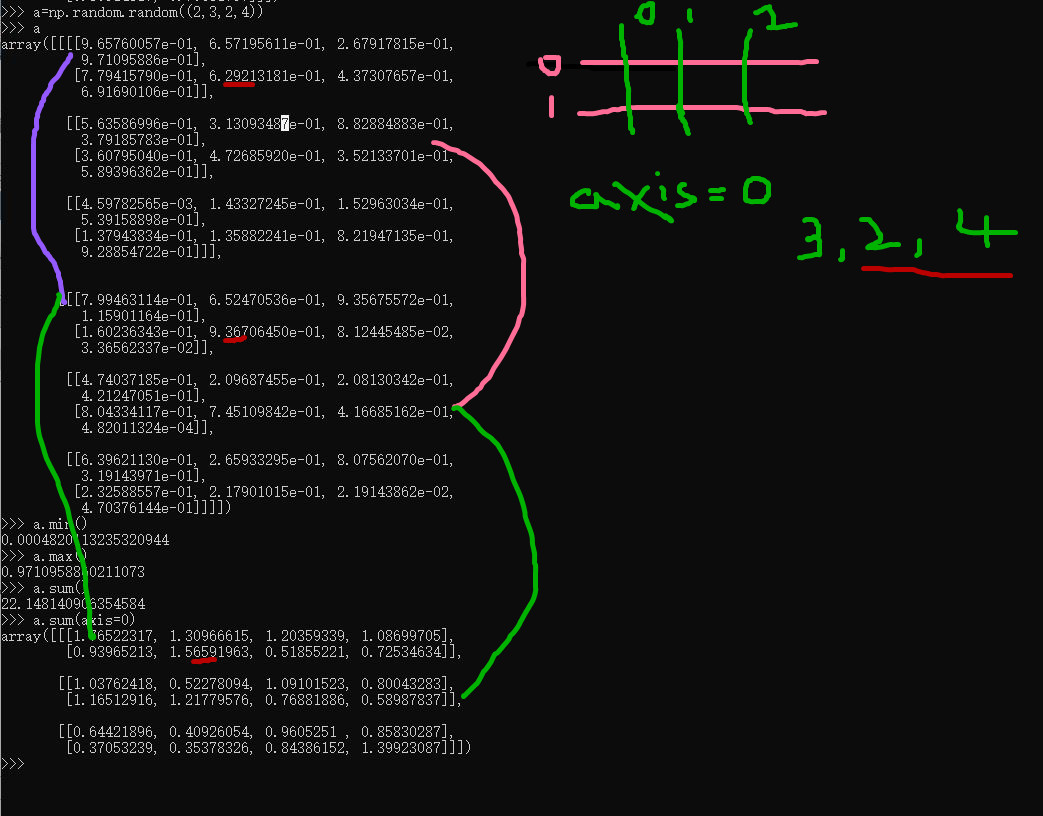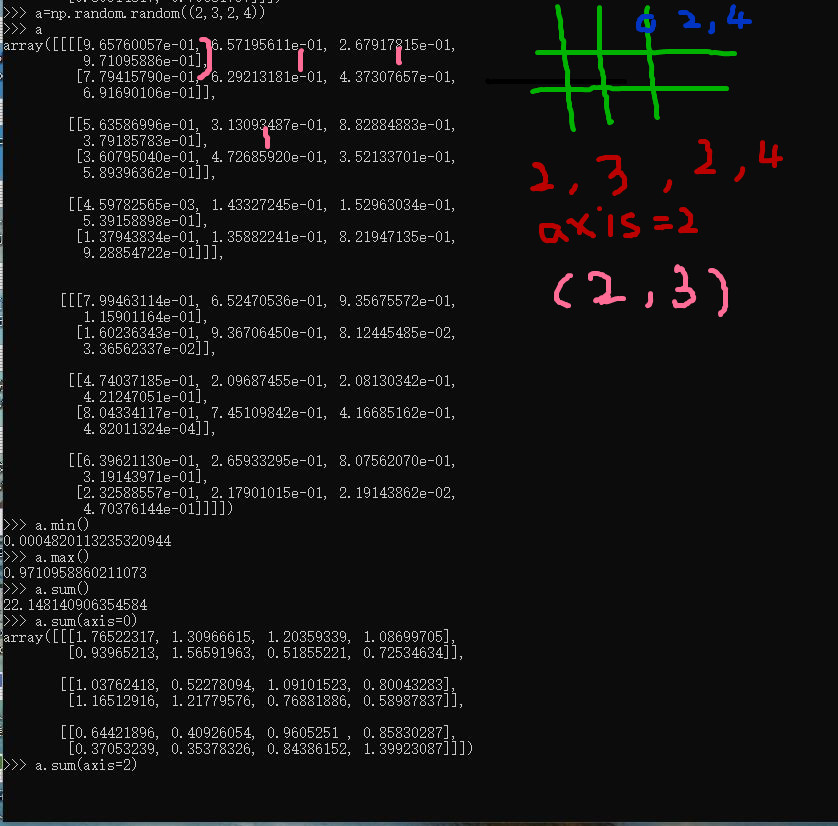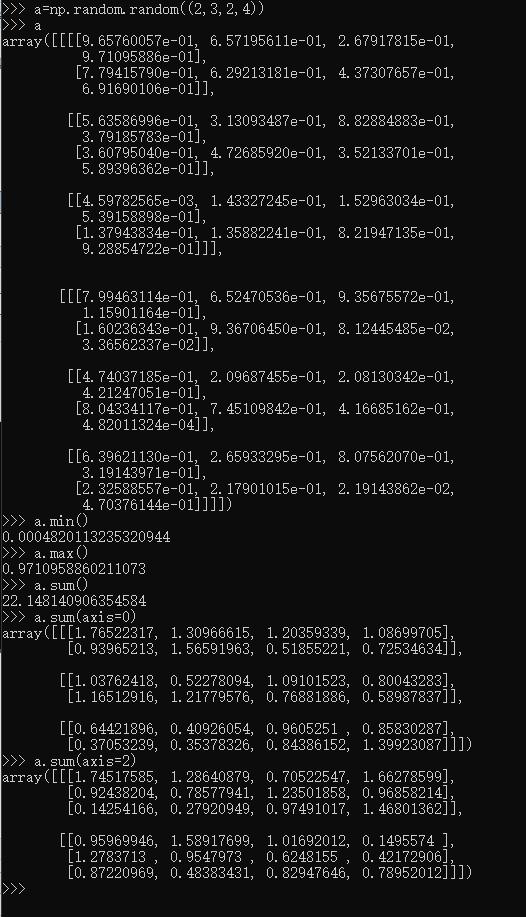科学计算 NumPy 与C语言对比 N-dimensional array ndarray 元素元素操作 计算正太分布分位数 ndarray中的所有元素的类型都是相同的,而Python列表中的元素类型是任意的,所以ndarray在存储元素时内存可以连续,而python原生list就只能通过寻址方式找到下一个元素
http://www.numpy.org/
NumPy is the fundamental package for scientific computing with Python. It contains among other things:
- a powerful N-dimensional array object
- sophisticated (broadcasting) functions
- tools for integrating C/C++ and Fortran code
- useful linear algebra, Fourier transform, and random number capabilities
https://scipy.org/
https://www.oschina.net/p/paradox?fromerr=SpBZmWnx

Numpy and Scipy Documentation — Numpy and Scipy documentation https://docs.scipy.org/doc/
NumPy User Guide https://docs.scipy.org/doc/numpy-1.14.2/numpy-user-1.14.2.pdf
c = []
for i in range(len(a)):
c.append(a[i]*b[i])
This produces the correct answer, but if a and b each contain millions of numbers, we will pay the price for the
inefficiencies of looping in Python. We could accomplish the same task much more quickly in C by writing (for clarity
we neglect variable declarations and initializations, memory allocation, etc.)
for (i = 0; i < rows; i++): {
c[i] = a[i]*b[i];
}
This saves all the overhead involved in interpreting the Python code and manipulating Python objects, but at the
expense of the benefits gained from coding in Python. Furthermore, the coding work required increases with the
dimensionality of our data. In the case of a 2-D array, for example, the C code (abridged as before) expands to
for (i = 0; i < rows; i++): {
for (j = 0; j < columns; j++): {
c[i][j] = a[i][j]*b[i][j];
}
}
NumPy gives us the best of both worlds: element-by-element operations are the “default mode” when an ndarray is
involved, but the element-by-element operation is speedily executed by pre-compiled C code. In NumPy
c = a * b
does what the earlier examples do, at near-C speeds, but with the code simplicity we expect from something based on
Python. Indeed, the NumPy idiom is even simpler! This last example illustrates two of NumPy’s features which are
the basis of much of its power: vectorization and broadcasting.
Broadcasting is the term used to describe the implicit element-by-element behavior of operations; generally speaking,
in NumPy all operations, not just arithmetic operations, but logical, bit-wise, functional, etc., behave in this implicit
element-by-element fashion, i.e., they broadcast. Moreover, in the example above, a and b could be multidimensional
arrays of the same shape, or a scalar and an array, or even two arrays of with different shapes, provided that the smaller
array is “expandable” to the shape of the larger in such a way that the resulting broadcast is unambiguous. For detailed
“rules” of broadcasting see numpy.doc.broadcasting.
NumPy fully supports an object-oriented approach, starting, once again, with ndarray. For example, ndarray is a
class, possessing numerous methods and attributes. Many of its methods mirror functions in the outer-most NumPy
namespace, giving the programmer complete freedom to code in whichever paradigm she prefers and/or which seems
most appropriate to the task at hand.
NumPy’s main object is the homogeneous multidimensional array.
NumPy provides an N-dimensional array type, the ndarray, which describes a collection of “items” of the same type. The items can be indexed using for example N integers.
主对象 同构多维数组
字节计算
ndarray.ndim the number of axes (dimensions) of the array. ndarray.shape the dimensions of the array. This is a tuple of integers indicating the size of the array in each dimension. For a matrix with n rows and m columns, shape will be (n,m). The length of the shape tuple is therefore the number of axes, ndim. ndarray.size the total number of elements of the array. This is equal to the product of the elements of shape. ndarray.dtype an object describing the type of the elements in the array. One can create or specify dtype’s using standard Python types. Additionally NumPy provides types of its own. numpy.int32, numpy.int16, and numpy.float64 are some examples. ndarray.itemsize the size in bytes of each element of the array. For example, an array of elements of type float64 has itemsize 8 (=64/8), while one of type complex32 has itemsize 4 (=32/8). It is equivalent to ndarray.dtype.itemsize. ndarray.data the buffer containing the actual elements of the array. Normally, we won’t need to use this attribute because we will access the elements in an array using indexing facilities.
>>> import numpy as np >>> a = np.arange(15).reshape(3, 5) >>> a array([[ 0, 1, 2, 3, 4], [ 5, 6, 7, 8, 9], [10, 11, 12, 13, 14]]) >>> a.shape (3, 5) >>> a.ndim 2 >>> a.dtype.name 'int64' >>> a.itemsize 8 >>> a.size 15
Array Creation
创建元素为复数的多维数组
import numpy as np #b = np.array([[1.2, 3.4, 5.6],[9.8]],dtype=complex) #WRONG b = np.array([[1.2, 3.4, 5.6],[9.8,0,0]],dtype=complex) b1 = np.array([[1.2],[9.8]],dtype=complex)

To create sequences of numbers, NumPy provides a function analogous to range that returns arrays instead of lists.
When arange is used with floating point arguments, it is generally not possible to predict the number of elements obtained, due to the finite floating point precision. For this reason, it is usually better to use the function linspace that receives as an argument the number of elements that we want, instead of the step.
创建数字序列
>>> a=np.arange(4) >>> a array([0, 1, 2, 3]) >>> np.sin(a) array([0. , 0.84147098, 0.90929743, 0.14112001]) >>> a<1.1 array([ True, True, False, False]) >>>
浮点序列的去步长创建
Python 3.6.4 (v3.6.4:d48eceb, Dec 19 2017, 06:54:40) [MSC v.1900 64 bit (AMD64)] on win32
Type "help", "copyright", "credits" or "license" for more information.
>>> np.zeros((3,4))
Traceback (most recent call last):
File "<stdin>", line 1, in <module>
NameError: name 'np' is not defined
>>> import numpy as np
>>> np.zeros((3,4))
array([[0., 0., 0., 0.],
[0., 0., 0., 0.],
[0., 0., 0., 0.]])
>>> np.ones((2,3,4),dtype=np.int16)
array([[[1, 1, 1, 1],
[1, 1, 1, 1],
[1, 1, 1, 1]],
[[1, 1, 1, 1],
[1, 1, 1, 1],
[1, 1, 1, 1]]], dtype=int16)
>>> np.empty((2,3))
array([[1.35617218e+248, 9.77817447e+199, 6.01334515e-154],
[4.71049380e-309, 4.17201348e-309, 2.64227521e-308]])
>>> np.arange(0,2,0.3)
array([0. , 0.3, 0.6, 0.9, 1.2, 1.5, 1.8])
>>> from numpy import pi
>>> np.linspace(
... 0,2,9)
array([0. , 0.25, 0.5 , 0.75, 1. , 1.25, 1.5 , 1.75, 2. ])
>>> x=np.linspace(0,2*pi,100)
>>> x
array([0. , 0.06346652, 0.12693304, 0.19039955, 0.25386607,
0.31733259, 0.38079911, 0.44426563, 0.50773215, 0.57119866,
0.63466518, 0.6981317 , 0.76159822, 0.82506474, 0.88853126,
0.95199777, 1.01546429, 1.07893081, 1.14239733, 1.20586385,
1.26933037, 1.33279688, 1.3962634 , 1.45972992, 1.52319644,
1.58666296, 1.65012947, 1.71359599, 1.77706251, 1.84052903,
1.90399555, 1.96746207, 2.03092858, 2.0943951 , 2.15786162,
2.22132814, 2.28479466, 2.34826118, 2.41172769, 2.47519421,
2.53866073, 2.60212725, 2.66559377, 2.72906028, 2.7925268 ,
2.85599332, 2.91945984, 2.98292636, 3.04639288, 3.10985939,
3.17332591, 3.23679243, 3.30025895, 3.36372547, 3.42719199,
3.4906585 , 3.55412502, 3.61759154, 3.68105806, 3.74452458,
3.8079911 , 3.87145761, 3.93492413, 3.99839065, 4.06185717,
4.12532369, 4.1887902 , 4.25225672, 4.31572324, 4.37918976,
4.44265628, 4.5061228 , 4.56958931, 4.63305583, 4.69652235,
4.75998887, 4.82345539, 4.88692191, 4.95038842, 5.01385494,
5.07732146, 5.14078798, 5.2042545 , 5.26772102, 5.33118753,
5.39465405, 5.45812057, 5.52158709, 5.58505361, 5.64852012,
5.71198664, 5.77545316, 5.83891968, 5.9023862 , 5.96585272,
6.02931923, 6.09278575, 6.15625227, 6.21971879, 6.28318531])
>>> f=np.sin(x)
>>> f
array([ 0.00000000e+00, 6.34239197e-02, 1.26592454e-01, 1.89251244e-01,
2.51147987e-01, 3.12033446e-01, 3.71662456e-01, 4.29794912e-01,
4.86196736e-01, 5.40640817e-01, 5.92907929e-01, 6.42787610e-01,
6.90079011e-01, 7.34591709e-01, 7.76146464e-01, 8.14575952e-01,
8.49725430e-01, 8.81453363e-01, 9.09631995e-01, 9.34147860e-01,
9.54902241e-01, 9.71811568e-01, 9.84807753e-01, 9.93838464e-01,
9.98867339e-01, 9.99874128e-01, 9.96854776e-01, 9.89821442e-01,
9.78802446e-01, 9.63842159e-01, 9.45000819e-01, 9.22354294e-01,
8.95993774e-01, 8.66025404e-01, 8.32569855e-01, 7.95761841e-01,
7.55749574e-01, 7.12694171e-01, 6.66769001e-01, 6.18158986e-01,
5.67059864e-01, 5.13677392e-01, 4.58226522e-01, 4.00930535e-01,
3.42020143e-01, 2.81732557e-01, 2.20310533e-01, 1.58001396e-01,
9.50560433e-02, 3.17279335e-02, -3.17279335e-02, -9.50560433e-02,
-1.58001396e-01, -2.20310533e-01, -2.81732557e-01, -3.42020143e-01,
-4.00930535e-01, -4.58226522e-01, -5.13677392e-01, -5.67059864e-01,
-6.18158986e-01, -6.66769001e-01, -7.12694171e-01, -7.55749574e-01,
-7.95761841e-01, -8.32569855e-01, -8.66025404e-01, -8.95993774e-01,
-9.22354294e-01, -9.45000819e-01, -9.63842159e-01, -9.78802446e-01,
-9.89821442e-01, -9.96854776e-01, -9.99874128e-01, -9.98867339e-01,
-9.93838464e-01, -9.84807753e-01, -9.71811568e-01, -9.54902241e-01,
-9.34147860e-01, -9.09631995e-01, -8.81453363e-01, -8.49725430e-01,
-8.14575952e-01, -7.76146464e-01, -7.34591709e-01, -6.90079011e-01,
-6.42787610e-01, -5.92907929e-01, -5.40640817e-01, -4.86196736e-01,
-4.29794912e-01, -3.71662456e-01, -3.12033446e-01, -2.51147987e-01,
-1.89251244e-01, -1.26592454e-01, -6.34239197e-02, -2.44929360e-16])
>>>
>>> np.arange(20)
array([ 0, 1, 2, 3, 4, 5, 6, 7, 8, 9, 10, 11, 12, 13, 14, 15, 16,
17, 18, 19])
>>> np.arange(20).reshape(3,3)
Traceback (most recent call last):
File "<stdin>", line 1, in <module>
ValueError: cannot reshape array of size 20 into shape (3,3)
>>> np.arange(20).reshape(4,5)
array([[ 0, 1, 2, 3, 4],
[ 5, 6, 7, 8, 9],
[10, 11, 12, 13, 14],
[15, 16, 17, 18, 19]])
>>> np.arange(20,dtype=complex).reshape(4,5)
array([[ 0.+0.j, 1.+0.j, 2.+0.j, 3.+0.j, 4.+0.j],
[ 5.+0.j, 6.+0.j, 7.+0.j, 8.+0.j, 9.+0.j],
[10.+0.j, 11.+0.j, 12.+0.j, 13.+0.j, 14.+0.j],
[15.+0.j, 16.+0.j, 17.+0.j, 18.+0.j, 19.+0.j]])
随机数
多维数组
最值
>>> a=np.random.random((2,3,2))
>>> a
array([[[0.4952443 , 0.03868411],
[0.23719136, 0.47319592],
[0.13173682, 0.56206977]],
[[0.30565678, 0.71079902],
[0.55682919, 0.94712502],
[0.39514817, 0.70681757]]])
>>> a=np.random.random((2,3,2,4))
>>> a
array([[[[9.65760057e-01, 6.57195611e-01, 2.67917815e-01,
9.71095886e-01],
[7.79415790e-01, 6.29213181e-01, 4.37307657e-01,
6.91690106e-01]],
[[5.63586996e-01, 3.13093487e-01, 8.82884883e-01,
3.79185783e-01],
[3.60795040e-01, 4.72685920e-01, 3.52133701e-01,
5.89396362e-01]],
[[4.59782565e-03, 1.43327245e-01, 1.52963034e-01,
5.39158898e-01],
[1.37943834e-01, 1.35882241e-01, 8.21947135e-01,
9.28854722e-01]]],
[[[7.99463114e-01, 6.52470536e-01, 9.35675572e-01,
1.15901164e-01],
[1.60236343e-01, 9.36706450e-01, 8.12445485e-02,
3.36562337e-02]],
[[4.74037185e-01, 2.09687455e-01, 2.08130342e-01,
4.21247051e-01],
[8.04334117e-01, 7.45109842e-01, 4.16685162e-01,
4.82011324e-04]],
[[6.39621130e-01, 2.65933295e-01, 8.07562070e-01,
3.19143971e-01],
[2.32588557e-01, 2.17901015e-01, 2.19143862e-02,
4.70376144e-01]]]])
>>> a.min()
0.0004820113235320944
>>> a.max()
0.9710958860211073
>>>
有序二元组
(行,列)
(行,(行,列))
(行,(行,(行,列)))
Glossary — NumPy v1.13 Manual https://docs.scipy.org/doc/numpy-1.13.0/glossary.html
理解轴



https://zh.wikipedia.org/wiki/NumPy
NumPy参考CPython(一个使用字节码的解释器),而在这个Python实现解释器上所写的数学算法代码通常远比编译过的相同代码要来得慢。为了解决这个难题,NumPy引入了多维数组以及可以直接有效率地操作多维数组的函数与运算符。因此在NumPy上只要能被表示为针对数组或矩阵运算的算法,其运行效率几乎都可以与编译过的等效C语言代码一样快。[1]
NumPy提供了与MATLAB相似的功能与操作方式,因为两者皆为解释型语言,并且都可以让用户在针对数组或矩阵运算时提供较标量运算更快的性能。两者相较之下,MATLAB提供了大量的扩展工具箱(例如Simulink);而NumPy则是根基于Python这个更现代、完整并且开放源代码的编程语言之上。此外NumPy也可以结合其它的Python扩展库。例如SciPy,这个库提供了更多与MATLAB相似的功能;以及Matplotlib,这是一个与MATLAB内置绘图功能类似的库。而从本质上来说,NumPy与MATLAB同样是利用BLAS与LAPACK来提供高效率的线性代数运算。
https://baike.baidu.com/item/NumPy/5678437

NumPy provides an N-dimensional array type, the ndarray, which describes a collection of “items” of the same type.
NumPy提供了一个N维数组类型ndarray,它描述了相同类型的“items”的集合。
ndarray到底跟原生python列表的区别:
从图中我们可以看出ndarray在存储数据的时候,数据与数据的地址都是连续的,这样就给使得批量操作数组元素时速度更快。
这是因为ndarray中的所有元素的类型都是相同的,而Python列表中的元素类型是任意的,所以ndarray在存储元素时内存可以连续,而python原生list就只能通过寻址方式找到下一个元素,这虽然也导致了在通用性能方面Numpy的ndarray不及Python原生list,但在科学计算中,Numpy的ndarray就可以省掉很多循环语句,代码使用方面比Python原生list简单的多。
numpy内置了并行运算功能,当系统有多个核心时,做某种计算时,numpy会自动做并行计算。
Numpy底层使用C语言编写,数组中直接存储对象,而不是存储对象指针,所以其运算效率远高于纯Python代码。


